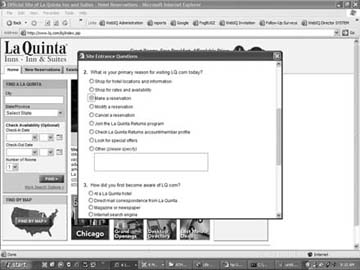Hack7.Understand Visitor Intent
Hack 7. Understand Visitor Intent
Despite the great body of knowledge that web measurement applications help you collect and organize, the intent of visitors when they come to your web site is nearly always part of the "great unknown" online. By recognizing this, you can often improve your overall understanding of the metrics, improving their value and use. If you ask any online retailer why people come to their web sites, they usually answer, "Well, to buy things of course!" While it sounds like a great answer, it is usually not true; if it were, retailers' buyer conversion rates would be much higher than the three percent widely reported. Most people who visit online retail sites are simply browsing or doing research and have no intention of making an online purchase. The problem is that order and buyer conversion rates [Hack #39] are built from the assumption that every visitor is a potential purchaser, a fallacious assumption if there ever was one. If retailers could build calculations based not on the entire audience, but only on the people who actually intended to purchase, conversion rates would likely shoot through the roof. By eliminating the tire kickers from the equation, business owners could focus on resolving problems experienced by visitors who actually had potential, not just promise. So if you could figure out the visitor's intent, your measurement problems would be solved. Indeed. Easier said than done, but there are two general strategies for determining visitor intent: explicitly and implicitly. 1.8.1. Determining Intent ExplicitlyDetermining intent explicitly is actually pretty easy if you think about ityou ask. Simply pop up a window when visitors arrive at your site and ask them in as polite a way possible "Why are you here today?" Present them with a reasonable list of options (for example, "To make a purchase," "To research your products and services," and "To get customer support") and pass their response to your measurement application. The best strategy for passing the response to your measurement application is to create visitor segments [Hack #48] from different "intent groups" based on their answers. Ideally, your measurement application will be sophisticated enough to then let you calculate differential conversion rates and generate value metrics for members of the intent group. For extra credit, when you can tell a visitor is leaving the site, pop up another window and ask her how you did in satisfying her stated intentions. A simple "Do you consider your visit to our site to be successful or unsuccessful?" will usually do, and is quick enough to not seriously impede the visitor as she's moving on. Knowing when the visitor is actually leaving your site is difficult to do unless you're keeping track of all the links that leave your site or using an external technology like Usability Sciences WebIQ (Figure 1-7). Do your best. Figure 1-7. Explicitly asking about visitor intent 1.8.2. Determining Intent ImplicitlyDetermining intent implicitly is the reason visitor segmentation was originally generated; visitor segmentation is the ability to make assumptions about visitors based on their clickstream, and then grouping them into segments for further analysis. To extend segmentation to create intent groups, all you need to do is think carefully about the events or actions that visitors are likely to make based on their intent. Using the retail examples provided above, it is fairly safe to assume that any visitor who clicks on a "checkout" button intends to make a purchase, any visitor who does not click on a "checkout" button was merely browsing, and anyone who clicks into your customer support pages is looking for customer support. These are very simple examples, and most sites aren't that simple. Still, if you start small and then carefully examine the segments you're creating, looking back into the group's general clickstream behavior, it is likely you'll be able to evolve the segment over time to be a more accurate predictor of intent. 1.8.3. Once You've Determined Intent, Then What?Once you've figured out what visitors actually came to your site to do, you can start building better metrics and key performance indicators [Hack #94]. Many of the KPIs presented in Chapter 7 of this book are dramatically improved by focusing them based on visitor intent.
Since tracking intent is moderately dependent on your application's ability to segment visitors, it is likely worth a call to your vendor to explain what you're trying to do. |
EAN: 2147483647
Pages: 157